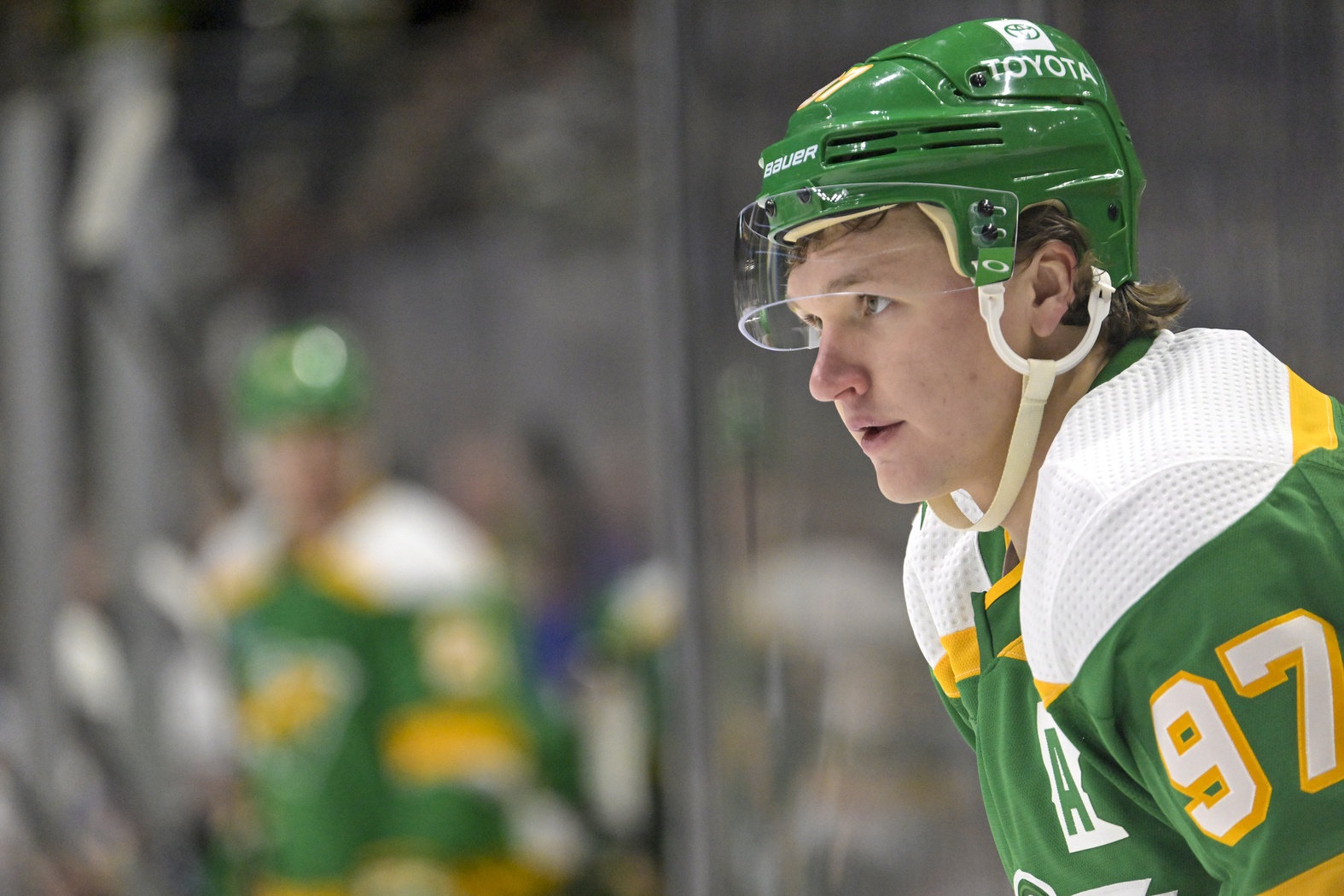
Kirill Kaprizov is undeniably the best forward on the Minnesota Wild. He consistently stick-handles his way to the most dangerous areas of the ice and finishes those chances at an elite rate.
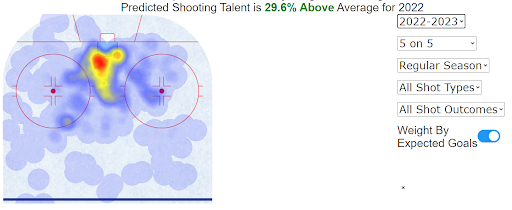
Courtesy of MoneyPuck.com
He’s a scoring machine. So why are his shootout numbers so average?
The Wild have called Kaprizov’s name for 23 shootout attempts in his NHL career, and he’s scored on only 30.4% of those attempts, per HockeyReference.com. Last year, the league average was about 35%.
That “NHL average” includes players who aren’t usually called upon by their coaches. To better understand the average, break down the scoring rate based on the number of shootout attempts they took. As expected, taking more shootout attempts correlates to better shootout success.
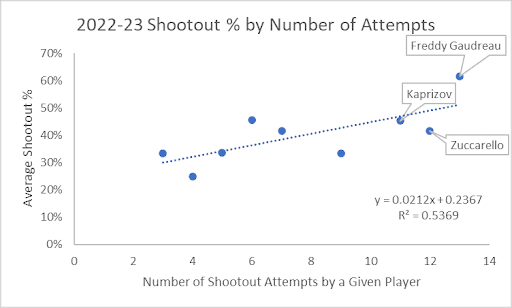
Wait a minute. Who are those guys in the top right? Kaprizov, Mats Zuccarello, and Freddy Gaudreau were the only players to take 11, 12, and 13 shootout attempts, respectively. Despite putting their shootout moves on the tape more than any other NHL player, they acquitted themselves quite well. Of the 99 players who took three or more shootout attempts, Zuccarello ranked 32nd in the NHL, Gaudreau ranked 17th, and Kaprizov ranked 29th.
Maybe all that practice did them well.
So why are Kaprizov’s career numbers so poor? Well, 2022-23 was his best season in the shootout.
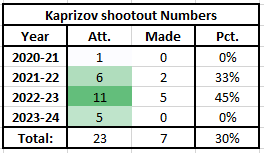
Maybe he was on a bit of a hot streak in 2022-23, but I think it’s more likely that he improved his shootout move during the first three years in the NHL. His 2023-24 numbers (0 for 5) also pull down his average. He was injured on December 30. Perhaps that’s affected his ability to combine deception and quick-twitch, both of which are critical to an effective shootout move.
Indeed, Kaprizov has looked much healthier lately, allowing him to pull this move off in a breakaway. He had so much time that he actually pulled out his shootout move.
So, what changes has Kaprizov made to improve his shootout move? First, let’s break down the current version. Kaprizov often takes a relatively straight approach up the right side of the ice. If the goaltender drops low too early, he’ll chip it into the top right corner.
His approach angle creates a constant threat of that chip shot. It’s a threat every moment that the puck is on Kaprizov’s forehand, and the goaltender must cover that corner. They must either stand tall or far out of the net to cut off that angle.
But if they remain rooted to that spot, Kaprizov darts to his forehand and beats them at the far post.
This backhand-to-forehand technique is shootout 101. For left-handed shooters, working right-to-left with speed forces a goaltender to time their push from the short-side post to the far-side post, and it’s hard to time that up with enough power to match the speed of a hockey player moving at full speed.
However, the short-side chip shot isn’t very common. Kaprizov employs this unique approach because it forces goaltenders out of the net, allowing him to score on the backhand.
The clip above is a blast from the past; Kaprizov was only 19 when he scored this goal. It was the only KHL shootout clip I could find, but it’s a different move than Kaprizov currently uses in the shootout. First, his approach angle is different. Note how long he stays on the left side of the ice before cutting back to the right. He also threatens a different attack in this move. He fakes a forehand far-side rather than threatening a short-side chip shot.
By the time Kaprizov reached the NHL, he had tightened his approach angle and added the chip shot. Note in the below clip that he crosses to the right side of the ice on the blue line, whereas in the KHL clip, he crosses center ice at the top of the circles. His NHL approach threatens a short-side chip shot for the entire approach.
Kaprizov put that chip shot on his tape twice throughout his sophomore season.
Goaltenders saw that and adjusted by standing tall to cover the chip shot. They would shift their weight to dive across the net to cover his move to the forehand. After a while, that opened him up to take more backhand shots. That’s the third move of the triple threat.
The clip below against Martin Jones of the San Jose Sharks is most instructive of Kaprizov’s triple-threat shootout move. Jones stays on his skates as long as possible, defending the high chip. As Kaprizov gets closer, Jones drifts back in his net and shrinks low, trying to cover as much lateral net as possible. He’s trying to wait out Kaprizov and force him to commit backhand or forehand. But Kaprizov goes high with his backhand, and there’s no way Jones can cover both posts and the top shelf.
Goaltenders have found that their best chance is to force Kaprizov into a high-degree-of-difficulty shot, either his chip shot or his high backhand. That led Kaprizov to take many backhand shots early in the 2022-23 season, including this tally against Chicago.
Once all those backhanders were on tape, Kaprizov started to put a little sizzle on his approach. In a shootout duel with Trevor Zegras, Kaprizov presented his Ph.D. thesis in shootout moves.
In this case, Kaprizov closes his hips to signal a backhand is coming. If goaltender John Gibson pushes early, Kaprizov can just shelf his backhander. Gibson respects the backhand, so Kaprizov makes a giant deke to the forehand.
Note the way Kaprizov leaves his hips pointing right, but his skates are still drifting left. His upper and lower body are totally separated when he dekes to the forehand. This deception demands a rare level of power and flexibility in the hips, and Kaprizov shows off both.
Consciously or unconsciously, the best goalies and defensemen read a player’s hips as the primary signal of a puck carrier’s intentions. For football fans, it’s one of the reasons that Justin Jefferson is such a deceptive route runner. Cornerback Patrick Peterson said, “I think that’s what makes it so difficult for guys to get a bead on him, because his body can lie to you.” Kaprizov’s body is also lying here. His hips, skates, and hands are baffling, making it impossible for goaltenders to position themselves properly and time their push.
His unique blend of power and flexibility allows Kaprizov to skate like this, freezing defenders for long offensive possessions.
That makes Kaprizov extremely deceptive in the shootout. Pavel Datsyuk was the master of this hip-flipping technique, which is why it’s all over his highlights.
Kaprizov’s shootout move has evolved. He has grown from the backhand move he used in the KHL, layering new threats on top of that to create a triple threat of the chip, forehand, or backhand. Now, he’s finding new ways to fake to one side or the other to keep opposing goaltenders guessing.
With Kaprizov apparently back to full health, it’s time for him to prove he’s one of the league’s best players in the shootout.
Think you could write a story like this? Hockey Wilderness wants you to develop your voice, find an audience, and we'll pay you to do it. Just fill out this form.
-
 3
3



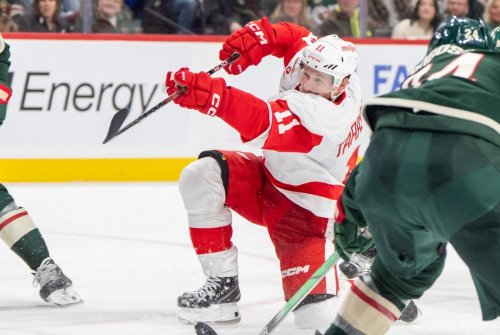
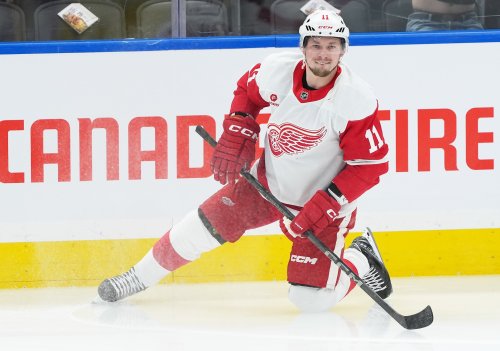


Recommended Comments
Join the conversation
You can post now and register later. If you have an account, sign in now to post with your account.
Note: Your post will require moderator approval before it will be visible.